“Some students are being counted twice if they are attending classes on multiple campuses,” said Miami University spokesperson Alecia Lipton.
The correct unduplicated enrollment for 2013 is 5,516 — a decrease of 35 percent in 10 years.
Lower college enrollment is being seen across the U.S. and is often attributed to a smaller demographic due to low birth rates and a change in mindset for prospective students. Ande Durojaiye, vice president of the regional campuses, said the decrease in students has not stopped the campuses from helping students — mostly from Hamilton and Middletown — and the surrounding community.
“While we have seen some decreases in students, we continue to meet the needs of the communities we serve with more varied education options than ever before,” Durojaiye said.
In 2013, Hamilton brought in $28.5 million in revenue from tuition and fees while having $28.5 million in total expenditures. In the same year, Middletown saw $19 million in revenue with $19 million in spending.
A decade later, the two campuses combined for $62.5 million in revenue while having the same amount in spending. In that same decade, Hamilton has gone from having 3,114 full-time employees to 1,821 while Middletown has decreased from 1,737 to 950, according to Miami University’s budgets.
Durojaiye said the decrease in employees is part of the campuses keeping the spending of tax-payer income under control and has not been done through layoffs or firings for the most part.
“As good stewards of public funds, we have aligned the number of full-time employees on our campuses to meet the need of students and ensure financial stability,” he said. “In most cases we’ve done so through targeted attrition by not filling vacated positions and retirements.”
Nationally, the number of students at community colleges fell 37% since 2010, or by nearly 2.6 million, according to the National Student Clearinghouse Research Center.
The Associated Press reports that while “four out of five students who begin at a community college say they plan to go on to get a bachelor’s degree, only about one in six of them actually manages to do it. That’s down by nearly 15% since 2020, according to the clearinghouse.”
One factor possibly leading to the decrease of college enrollment across the country is an increase in tuition and fees.
In 2013 in-state tuition and fees for Miami’s regional campuses was $5,072, while out-of-state students paid $14,166. Last year, in-state tuition and fees was $6,769 and out-of-state cost of attendance was $17,675.
Durojaiye said while fees rise, the campuses are aware of how students will react and are trying to combat prices.
“We know that affordability continues to be one of the biggest barriers to students pursuing higher education, whish is most evident in the communities the regional campuses serve,” he said.
Despite the raise in tuition and fees, Miami University budgets for 2022 and 2023 show the regional campuses have the same amount of revenue as they do expenses.
The campuses are branching out from a traditional college education in 2026 with the recent purchase of the nearly 55-acre Vora Technology Park at 101 Knightsbridge Drive in Hamilton in partnership with Butler Tech and the city of Hamilton.
Miami will hold a spot inside the proposed Advanced Manufacturing and Innovation Hub at Vora. The hub will offer training for jobs in the manufacturing sector as part of a partnership with the Butler Tech Career Center.
The program will open January 2026, according to Durojaiye.
About the Author
